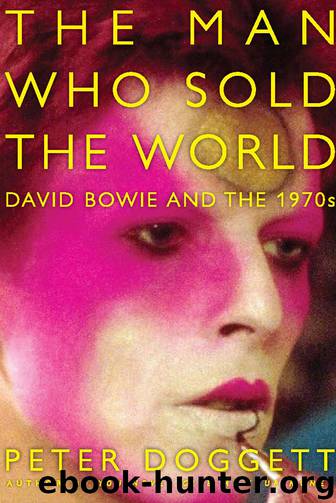The Man Who Sold the World by Peter Doggett

Author:Peter Doggett
Language: eng
Format: epub
Publisher: HarperCollins
[118] SOMEBODY UP THERE LIKES ME
(Bowie)
Recorded August and November 1974; Young Americans LP
* * *
REALLY, I’M A ONE-TRACK PERSON. WHAT I’VE SAID FOR YEARS UNDER VARIOUS GUISES IS, “WATCH OUT, THE WEST IS GOING TO HAVE A HITLER!” I’VE SAID IT IN A THOUSAND DIFFERENT WAYS. THAT SONG IS YET ANOTHER WAY.
—David Bowie, August 1974
Aldous Huxley was the first commentator to recognize the similarities between the techniques used by the advertising industry and the way in which Adolf Hitler was “sold” to the German public in the thirties. His account of Hitler’s emotional manipulation of his audiences read like an account of a performance by a teenage pop idol: “Strong emotion (as every actor and dramatist knows) is in the highest degree contagious. Infected by the malignant frenzy of the orator, the audience would groan and sob and scream in an orgy of uninhibited passion. And these orgies were so enjoyable that most of those who had experienced them eagerly came back for more.” The next step was to “brand” Hitler as an ad agency would brand cigarettes: “Hitler induced the German masses to buy themselves a Fuhrer, an insane philosophy, and the Second World War,” Huxley concluded. The historian of fascist iconography Steven Heller has taken the comparison further: “It could be argued that this self-proclaimed artist [Hitler was an aspiring painter] conceived his horrific plans as a massive socio-political Gesamtkunstwerk (total work of art) built on the notions of racial purification, nationalist regeneration, and world domination. These were integrated in an overall graphic scheme . . . [that] ultimately became a textbook example—indeed, a perverse paradigm—of corporate branding.”
Bowie recognized the insidious attraction of the Nazi brand, allowing it to influence his iconography (the “SS” lightning flash across his face on the cover of Aladdin Sane) and staging (the stark spotlighting of the stage on his 1976 world tour). He also knew the potency of his own branding as a star: what else was Ziggy Stardust but a demonstration of that effect? “Somebody Up There Likes Me” (its title purloined from a 1956 Paul Newman movie about boxing champ Rocky Graziano) explored his confusing relationships with advertising, stardom, and power. It built upon the melodic framework, though with a revised chord structure, of “I Am Divine” [192]—a song that, like his more recent “Shilling the Rubes” [112], seemed to have a specific predator in mind. Now Bowie was casting his net into an ocean of sharks, himself included.
At times, he sounded like a jaundiced political commentator of the old school, complaining that in the TV age, appearance counted more than substance. The obvious target was “Tricky Dick” Nixon, who had just resigned from the US presidency because of his involvement in the Watergate scandal, and the frequent target of the question “Would you buy a used car from this man?” Yet Bowie’s attack on Nixon seemed tame alongside more pointed barbs from singers such as Stevie Wonder (whose attack on the former president, “You Haven’t Done Nothin’,” charted the week that Bowie’s sessions began).
Download
This site does not store any files on its server. We only index and link to content provided by other sites. Please contact the content providers to delete copyright contents if any and email us, we'll remove relevant links or contents immediately.
| Classical | Country & Folk |
| Heavy Metal | Jazz |
| Pop | Punk |
| Rap & Hip-Hop | Rhythm & Blues |
| Rock |
Cecilia; Or, Memoirs of an Heiress — Volume 3 by Fanny Burney(31750)
Cecilia; Or, Memoirs of an Heiress — Volume 2 by Fanny Burney(31715)
Fanny Burney by Claire Harman(26483)
We're Going to Need More Wine by Gabrielle Union(18906)
Plagued by Fire by Paul Hendrickson(17291)
All the Missing Girls by Megan Miranda(15398)
Cat's cradle by Kurt Vonnegut(15101)
Bombshells: Glamour Girls of a Lifetime by Sullivan Steve(13928)
Leonardo da Vinci by Walter Isaacson(13106)
For the Love of Europe by Rick Steves(12345)
4 3 2 1: A Novel by Paul Auster(12221)
Adultolescence by Gabbie Hanna(8783)
The remains of the day by Kazuo Ishiguro(8748)
Note to Self by Connor Franta(7587)
Diary of a Player by Brad Paisley(7416)
Giovanni's Room by James Baldwin(7117)
What Does This Button Do? by Bruce Dickinson(6100)
Ego Is the Enemy by Ryan Holiday(5228)
Born a Crime by Trevor Noah(5213)
